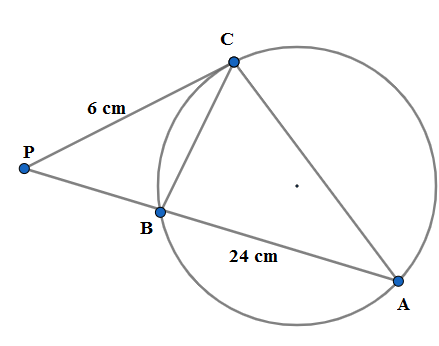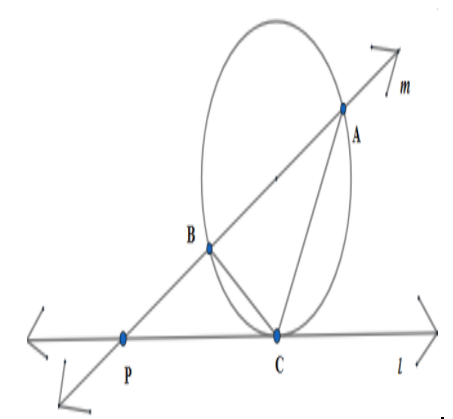
The chord $CB$ and tangent $CP$ at a point $C$ on the circle intersect at $P$ externally. The value of $CP=6$cm, $AB=24$ cm. Find PB. \[\]
A.15 cm \[\]
B.0.5 cm \[\]
C.1.5 cm\[\]
D. 1.51 cm \[\]


Answer
558k+ views
Hint: We recall the definition of tangent and secant to a circle. We use the tangent secant theorem which states that if two tangent and secant meet externally at point P, the point of contact of the tangent is C and the points of intersection of the secant with the circle are B and A then $P{{C}^{2}}=PB\cdot AB$.
Complete step-by-step solution
We know that a tangent line to a circle is a line that touches the circle at exactly one point, never entering the circle's interior. The point at which the tangent touches the circle is called the point of contact. The secant of a circle is a line that cuts the circle at two points. The line segment that is formed by the points of intersection is called a chord.\[\]
We draw tangent line $l$ whose point of contact is C and secant line $m$ which makes chord BA in the circle. The tangent and the secant meet at point P. \[\]

We know from the tangent secant theorem that the square of length the point of contact to the point of intersection of tangent and secant (CP) is equal to the product of the length of the chord (AB) and length of the point of intersection of tangent and the secant to the first point of inspection of secant and the circle (PB ). So we have;
\[C{{P}^{2}}=AB\cdot PB\]
We are given in the question the length of $CP=6$cm and the length of $AB=24$cm. We put these values in the above formula to have
\[\begin{align}
& \Rightarrow {{6}^{2}}=24\cdot PB \\
& \Rightarrow 36=24\cdot PB \\
& \Rightarrow PB=\dfrac{36}{24}=1.5 \\
\end{align}\]
So the length of PB is 1.5cm and the correct option is D.
Note: We note that in the formula $C{{P}^{2}}=AB\cdot PB$ the lengths BC and AC are irrelevant. A tangent secant theorem is a specialized form of intersecting secants theorem which states that if lines $l$ and $m$ which intersect at the point $P$ cut the circle at the points $A, B$ and $C, D$ then line segments created by secants $l,m$ are related as $PA\cdot PB=PC\cdot PD$.
Complete step-by-step solution
We know that a tangent line to a circle is a line that touches the circle at exactly one point, never entering the circle's interior. The point at which the tangent touches the circle is called the point of contact. The secant of a circle is a line that cuts the circle at two points. The line segment that is formed by the points of intersection is called a chord.\[\]
We draw tangent line $l$ whose point of contact is C and secant line $m$ which makes chord BA in the circle. The tangent and the secant meet at point P. \[\]

We know from the tangent secant theorem that the square of length the point of contact to the point of intersection of tangent and secant (CP) is equal to the product of the length of the chord (AB) and length of the point of intersection of tangent and the secant to the first point of inspection of secant and the circle (PB ). So we have;
\[C{{P}^{2}}=AB\cdot PB\]
We are given in the question the length of $CP=6$cm and the length of $AB=24$cm. We put these values in the above formula to have
\[\begin{align}
& \Rightarrow {{6}^{2}}=24\cdot PB \\
& \Rightarrow 36=24\cdot PB \\
& \Rightarrow PB=\dfrac{36}{24}=1.5 \\
\end{align}\]
So the length of PB is 1.5cm and the correct option is D.
Note: We note that in the formula $C{{P}^{2}}=AB\cdot PB$ the lengths BC and AC are irrelevant. A tangent secant theorem is a specialized form of intersecting secants theorem which states that if lines $l$ and $m$ which intersect at the point $P$ cut the circle at the points $A, B$ and $C, D$ then line segments created by secants $l,m$ are related as $PA\cdot PB=PC\cdot PD$.
Recently Updated Pages
Two men on either side of the cliff 90m height observe class 10 maths CBSE

What happens to glucose which enters nephron along class 10 biology CBSE

Cutting of the Chinese melon means A The business and class 10 social science CBSE

Write a dialogue with at least ten utterances between class 10 english CBSE

Show an aquatic food chain using the following organisms class 10 biology CBSE

A circle is inscribed in an equilateral triangle and class 10 maths CBSE

Trending doubts
Why is there a time difference of about 5 hours between class 10 social science CBSE

Write a letter to the principal requesting him to grant class 10 english CBSE

What is the median of the first 10 natural numbers class 10 maths CBSE

The Equation xxx + 2 is Satisfied when x is Equal to Class 10 Maths

Which of the following does not have a fundamental class 10 physics CBSE

State and prove converse of BPT Basic Proportionality class 10 maths CBSE




